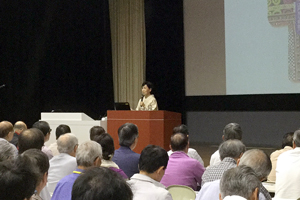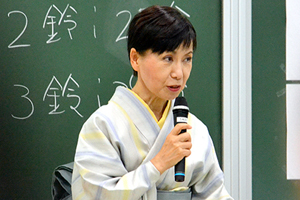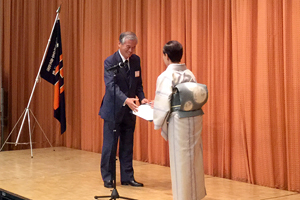Thursday, June 30
I gave a special lecture at the Seikado Bunko Art Museum in Setagaya, Tokyo, during the "Natural History of Edo" exhibition. The title of the lecture was "Edo Culture and Herbalism. It had been a while since I gave a lecture on my own specialty. What I discovered through the lecture was that learning is not unrelated to the needs of the people of the time. Even in the Edo period, learning grew up in an environment of world learning. Honzōgaku was heavily influenced and changed by natural history, which emerged as a way to learn about the world's nature. Natural history painting as documentation influenced painting, which in turn changed the entire culture of the time. Today, we too must consider how what we do at the university is connected to the rest of the world and how it might change in the future.
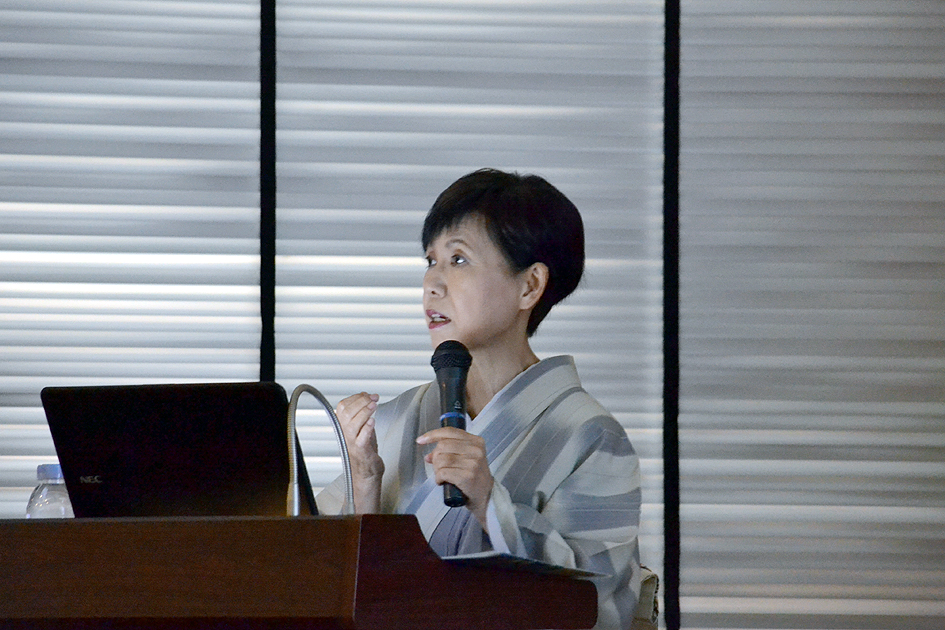
Monday, June 27
The general meeting of the Alumni Association was held. The Alumni Association is a general incorporated association with a delegate system. One delegate is elected for every 40 regular members, mainly from each prefectural alumni association, and various decisions are made at the general meeting. We can help each other with work and other matters, whether overseas or in Japan. Future alumni are encouraged to attend Alumni Association events and network with each other when they return home or are assigned to new locations. Through the Alumni Association, the university may be able to support you after graduation.
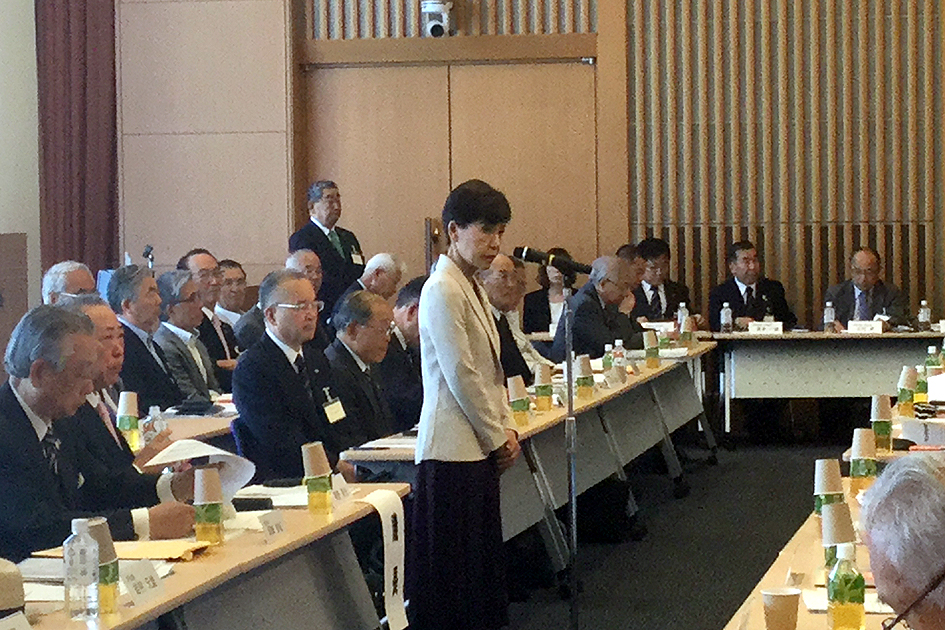
June 26 (Sunday)
A joint information session was held for the three affiliated schools (junior high, junior high and high school, and girls' high school). As last year, the President lecture was followed by a discussion with Professor Naoki Ogi, Director of the Center for Teaching Curriculum. The lecture was about the promise made at the beginning of the Hosei University Hosei University Charter, " Practical Wisdom for Freedom.
As the world becomes increasingly fluid, we will work in many different places around the world and in Japan. Professor Kathy Davidson of the City University of New York has said that "65% of elementary school students entering the 2011 school year in the United States will be working in jobs that do not exist today when they graduate from college," and other theories say that about 45% of jobs will be automated. Under these circumstances, students entering junior high and high schools in the future will need to acquire "the ability to think, judge, and express themselves," but Hosei University also wants them to have ideals. We hope that you will polish your knowledge through various practices, aiming for a world where any person can live in freedom. The three affiliated schools have already incorporated group work, discussions, and presentations into their classes. The students were introduced to these activities.
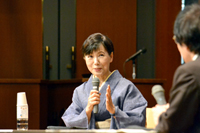
Mr. Ogi taught us how to face "failure" in the "self-determination" process. It was to listen to the students. He told us that by fully listening to what was behind the failures, it is important for students to know the causes and overcome them on their own. It was another fruitful joint information session this year.
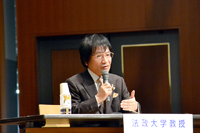
June 25 (Saturday)
There was a ceremony to award the scholarships for outstanding academic achievement, and afterwards, I had a chance to meet and talk with the scholarship recipients. Congratulations to all of you. Please remember what you have worked on over the past four years and test your own potential to the fullest when you go out into the world.
Since I supervise doctoral students, I attended the mid-term presentation of the dissertation of the third-year students of the Institute of International Japanese Studies doctoral program. In this graduate school composed of many international students, the themes of their doctoral dissertations vary from Hawaiian-Okinawan, Korean envoys to Japan during the Edo period, studies of famous places, natural history, classical literature, historical novels, education-related topics, potted plant theory, and so on. Italians, Russians, and Chinese are also writing high-level Japanese-language theses.
June 17 (Friday)
A roundtable discussion for College Management, a higher education magazine by Recruit Institute for Higher Education Research, was held at the headquarters of Recruit Holdings in Marunouchi. From national universities, it was President Koetsu Yamazaki of Kanazawa University, from public universities, President Michiaki Kondo of the University of Kitakyushu, and from private universities, it was me. The facilitator was Professor Hiromichi Yoshitake of the University of Tsukuba's Education Center. We talked about everything from the role of the university president to the difficulties of university management, and the recent reforms at local public universities are remarkable. It was very stimulating.
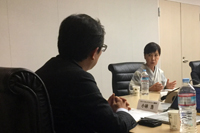
June 16 (Thursday)
The usual self-assessment roundtable meeting was held, at which faculties present their features. From this year, one affiliated school was also included this year, and we were able to hear the presentation by Hosei Girls' High School. Although the presentation was strictly limited to eight minutes per faculty, the enthusiasm and vision of each faculty was evident. Hosei University is a place where each faculty has a strong individuality.
June 11 (Saturday)
The Tochigi Alumni Association General Meeting was held in Utsunomiya, and I gave a lecture on " Practical Wisdom for Freedom " at a lecture meeting organized by the Alumni Association and attended by the general public.
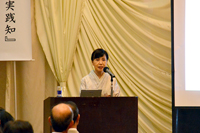
June 10 (Friday)
It was the day of the Sanno-sha (Hie Shrine in Akasaka) Sanno Festival (7th - 17th). Hosei University is a Ujiko of Sanno-sha. Five staff members gathered at Hie Shrine at 6:30 a.m., and from there we pulled a float in the 300-meter-long festival procession, passing in front of the Ichiguchizaka School Building. From there, I joined the procession as a Ujiko of Kudan 3-chome and walked with it until it was handed over to the Ujiko of 4-chome. The parade consisted of two imperial palanquins, a mikoshi shrine, five floats, and about 500 people in imperial court costume and Ujiko (shrine parishioners). I was able to see the entire procession, and the costumes of the imperial family are elegant and different from those of other festivals. This is the Tenka Matsuri (festival to be carried into Edo Castle), which has been held in annual rotation with Kanda Myojin since the Edo period (1603-1868). The Shogun welcomed the festival into the castle, but the Emperor's family did not, so the festival was not allowed into the Imperial Palace. The Shoguns return to the castle at the Sakashimon gate, and the procession returns to Sanno-sha through Nihonbashi, Ginza, and Shinbashi.
Incidentally, Hosei University is the closest shrine to Yasukuni Shrine, but Yasukuni Shrine is not a traditional Japanese shrine rooted in the community, but an organization of "State Shinto", a modern emerging religion, and was created only for the war dead of Japan, so it has no Ujiko in the community.
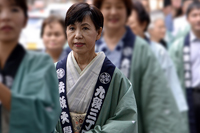
The 2016 annual meeting of JMOOC (Japan Massive Open Online Course) was held at Meiji University's Ochanomizu Campus, where I spoke as an invited speaker about the potential of online classes at universities. As already announced, Hosei University started to deliver lectures to JMOOC in January this year, and I delivered the first lecture. 70,000 words were written and four weeks of lectures were delivered, and I spoke about the possibilities and problems of JMOOC based on my experience. Can MOOCs, which are already being deployed around the world, be disseminated from Japan and used by universities? The other speaker was Yuichiro Anzai, an advisor to the Ministry of Education, Culture, Sports, Science and Technology (former chairman of the Chukyo Council), who is leading the "High School-University Connection" initiative to create a new entrance examination. Online is going to become indispensable for entrance examinations, but more importantly, how can online help develop new skills? It is time to think seriously about this.
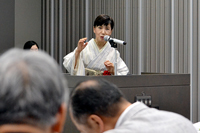
June 7 (Tuesday)
I had a conversation with Aya Kamikawa, a Setagaya Ward Council member, on HOSEI ONLINE. At the entrance ceremony of Hosei Ni-High School this year, Principal Masanori Kitazume congratulated Ms. Uekawa on the school's co-ed status and introduced her book, "The Courage to Change: From My Gender Identity Disorder" (Iwanami Shinsho) and how she spent her time at Hosei Ni-High School. I was impressed by the way he spoke to the students about how proud he was of Ms. Kamikawa in his position as principal, and since the university is preparing a "Diversity Declaration," I thought I would like to meet her and have her speak to the students on the website.
Mr. Kamikawa is exactly (or even more) what I had expected: a person who clearly aims for a society where diverse people, including himself, can live within it, while firmly accepting the difficult realities of life. People are divided into two groups: those who wish for their own happiness (or lament their bad luck), and those who take action to change society as a whole, including themselves. Practical Wisdom for Freedom " is the intelligence for the latter. Mr. Kamikawa will continue to Practical wisdom lot of Practical wisdom.
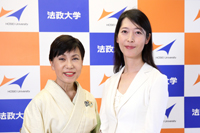
The annual meeting of the Japan Association of Mayors (a gathering of mayors who graduated from Hosei University) was held. Mayor Naomichi Suzuki of Yubari City brought in melons, making the meeting even more lively. The price of Yubari melons sold for the first time this year was 1.5 million yen per melon. If you have them at the right time, they have a complex and elegant aroma and taste, unlike other melons, as if you are drinking a fine wine. I hope many people buy them for Yubari City, which continues to pay back its enormous debt. I wrote a chapter about the mayor of Yubari in "Freedom, the Plaza", so please read it.
On this day, the constitution of the National Association of Mayors was officially established and inaugurated. It is said that the Mayors Association can have as its members any governor, ward mayor, and city or ward councilor who is recommended by the city or ward mayor, as long as they are graduates of Hosei University. We look forward to the expansion of the Mayors' Association.
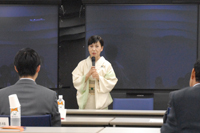
Monday, June 6
Mr. Li Shuxin, Director of the School Affairs Committee (Chief Executive Officer) of Shandong University in Shandong Province, China, with which we have an agreement on academic exchange (general agreement), and several other people visited us. We were amazed at the size of Shandong University and its magnificent school buildings and facilities. Education in China is still based on the "teach, learn, and follow" method, but this is no longer the case in some places. If these national universities were to put serious effort into encouraging independent and creative learning by students, they would become global educational centers on par with those in Europe and the United States. Japanese universities cannot afford to sit on their laurels.
I received a replica of an ancient bronze accessory hanger as a souvenir, which was excavated by an archaeology professor from under the university grounds. The souvenirs are of a different caliber! Hosei University also has many excavated artifacts. I thought a replica of an Edo period vessel would be a good idea.
June 4 (Saturday)
The Japan Society of Water Resources and Environment held a meeting at Hosei University, where I gave a speech on water control and environmental conservation in the Edo period and the use of rivers in the city. As our mission is to build a sustainable society, we hope that such conferences will flourish at our university.
On this day, the new and old officers of the Hosei University Supporters' Association held a general meeting and reception, and the president of the Supporters' Association was replaced. We would like to express our sincere gratitude to Chairman Akira Kobayashi, who has always been there for students in spite of being the president of a corporation. Thank you very much. The new chairman, Mr. Kazuhito Sobue, is also an alumnus of our university. I look forward to working with you all during the year.
June 3 (Fri.)
New EducationExpo 2016, with a 20-year history, was held in Ariake. Tokyo and Osaka will be the venues for the event, and satellites will be created and disseminated in five locations across Japan. In Tokyo, many lectures and seminars were open to the public over the three days, and the exhibition hall of ICT-related companies was also crowded. Keynote speakers were Yuichiro Anzai, President of Trustee Japan Society for the Promotion of Science and Advisor to the Ministry of Education, Culture, Sports, Science and Technology; Juichi Yamakawa, President Kyoto University; Norihiko Suzuki, Trustee and CEO of Akita International University; and myself. I came to talk about what is needed in this era of reform, which has reached a major turning point, such as high school-university connections and active learning.
The seminar was also held to commemorate the establishment of the Japan IMS Association for establishing learning resources with big data and internationalizing educational standards, an area of great interest since ICT education can only be made compatible in content and credits through international standardization.
In the waiting room, I had a chance to talk with Mr. Hiroshi Suzuki, Assistant to the Minister of Education, Culture, Sports, Science and Technology, and we had a very stimulating conversation about the relationship between the abilities to be developed and the entrance examination method, and the problems between science and arts fields. I have met Mr. Suzuki from time to time at Seigo Matsuoka's Editorial Engineering Research Institute. The "deliberation" that he practices is very interesting as a mechanism for people to deepen their understanding of each other beyond the system, and he is a politician of rare (excuse me!) ability. He is a man of broad, deep, and speedy insight, which is rare among politicians (pardon me!).
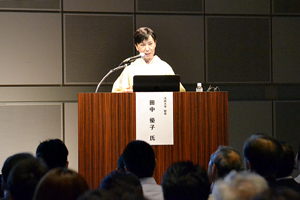
June 2 (Thursday)
I gave a talk titled "The Power of Cloth: Things and People in the Edo Period" in a relay lecture supervised by Jitsuro Terashima at Tama University. Tama University is a university whose president is Mr. Terashima Jitsuro, a frequent guest on "Sunday Morning. The relay course supervised by the president is a course for working people and students, and is now in its ninth year as the "Contemporary World Analysis Course. Students can also take the course, but working people from far and wide participate in it. Mr. Terashima has a "Terashima Library" in Kudanshita, where he also holds numerous lectures, dialogues, and symposiums. It is a wonderful and enviable thing that the president of a university can solely face the outside world and enhance the value of the university in this way. This is the advantage of a university where the Trustee and president are separated.
